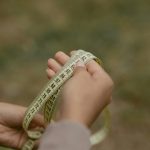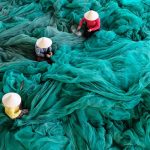Are you tired of your knit fabric projects turning out wonky and misshapen? Sewing with knit fabric can be a challenge, but with the right stabilizing techniques, you can achieve professional-looking results.
In this article, we’ll guide you through the process of stabilizing knit fabric for sewing, from understanding the challenges to troubleshooting common issues.
One of the main challenges of sewing with knit fabric is its stretchiness. Unlike woven fabrics, knit fabrics have a lot of give, which can make them difficult to sew without distortion. This can result in uneven seams, puckering, and stretched-out areas.
However, with the right stabilizing techniques, you can control the stretch and prevent these issues. In the following sections, we’ll explore various stabilizing methods and help you choose the right one for your project.
Table of Contents
Understand the Challenges of Sewing with Knit Fabric
Sewing with knit fabric can be a bit tricky, so it’s important to understand the challenges you may face. Unlike woven fabrics, knit fabrics have a lot of stretch which means they can be more difficult to control when sewing. This can lead to puckering, stretching, and uneven seams. It’s important to take your time and use the right techniques to stabilize the fabric before you start sewing.
One of the main challenges when sewing with knit fabric is preventing it from stretching out of shape. To avoid this, you can use a stabilizer or interfacing. This will provide extra support and help keep the fabric in place while you sew. Another option is to use a walking foot or a dual feed system on your sewing machine, which will ensure that the fabric is fed evenly through the machine.
Another challenge when sewing with knit fabric is the possibility of the fabric curling or rolling up at the edges. This can make it difficult to sew straight seams. To prevent this, you can use a spray adhesive or a temporary fabric adhesive to hold the fabric in place. You can also try using a rotary cutter to cut the fabric, rather than scissors, as this can help prevent the fabric from curling.
By understanding these challenges and using the right techniques, you can successfully sew with knit fabric and create beautiful, professional-looking garments.
Choose the Right Stabilizing Technique
When selecting the appropriate technique, it’s crucial to consider the type of knit material and the desired outcome for your project. Here are three techniques you can choose from:
-
Interfacing: This technique involves using a fusible interfacing to add stability to the fabric. It’s perfect for lightweight knits that need a little extra support. You can use a knit interfacing or a woven interfacing, but make sure it’s compatible with your fabric. Interfacing is applied to the wrong side of the fabric, using an iron or a press cloth.
-
Clear Elastic: This technique involves sewing a clear elastic along the seam line to prevent the fabric from stretching out of shape. It works well for medium to heavy weight knits. The elastic should be stretched slightly as you sew it along the seam line. Make sure to use a ballpoint needle and adjust your stitch length to accommodate the elastic.
-
Stay Tape: This technique involves using a narrow strip of stay tape to stabilize the fabric along the seam line. It’s perfect for lightweight to medium weight knits. Stay tape is applied to the wrong side of the fabric, using a straight stitch. It’s important to sew along the seam line to prevent the fabric from stretching out of shape.
Remember, the right stabilizing technique can make a big difference in the final outcome of your project. Take the time to choose the right method for your fabric and desired outcome. Happy sewing!
Prepare Your Fabric
Before you dive into your project, make sure you’ve taken the time to properly prepare your chosen material. This is especially important when working with knit fabric, as it can stretch and distort easily during sewing.
The first step in preparing your knit fabric is to prewash it. This will help to remove any excess dye or chemicals that may cause the fabric to shrink or change shape after the garment is made.
After prewashing, it’s important to dry your knit fabric flat, or hang it up to air dry. Avoid using a dryer, as this can cause the fabric to shrink and lose its stretch.
Once your fabric is dry, you can begin to stabilize it for sewing. This can be done by using a variety of techniques, such as using interfacing, fusible webbing, or stabilizing tape.
When choosing a stabilizing technique, consider the weight and stretch of your knit fabric. A heavier knit may require a stronger stabilizer, while a lightweight knit may only need a light interfacing.
It’s also important to test your stabilizer on a scrap piece of fabric before applying it to your entire garment. This will help to ensure that the stabilizer does not change the drape or stretch of the fabric.
Properly preparing and stabilizing your knit fabric will help to ensure that your finished garment looks and fits the way you intended.
Apply Your Stabilizer
One key step in ensuring a successful and well-fitting knit garment is properly applying the chosen stabilizer. Here are four tips to help you apply your stabilizer correctly and effectively:
-
Choose the right type of stabilizer for your knit fabric. There are many types of stabilizers available, including fusible, knit, and tear-away. Make sure to choose the one that’s most appropriate for your particular knit fabric.
-
Cut your stabilizer to the correct size and shape. Before applying your stabilizer, measure your fabric and cut the stabilizer to the same size and shape. This’ll ensure that the stabilizer provides full coverage and support to your knit fabric.
-
Apply the stabilizer to the wrong side of your fabric. Place the stabilizer on the wrong side of your fabric, making sure that it’s centered and not overlapping the edges. Use a hot iron to fuse the stabilizer in place, following the manufacturer’s instructions.
-
Use a pressing cloth to protect your fabric. When fusing the stabilizer to your fabric, use a pressing cloth to prevent the iron from directly touching the fabric. This’ll prevent any unwanted scorch marks or damage to your knit fabric.
By following these simple steps, you can ensure that your knit fabric is properly stabilized and ready for sewing. Don’t skip this important step in the sewing process, as it can make all the difference in the final fit and appearance of your finished garment.
Sewing Your Knit Fabric
Now it’s time to stitch your cozy knit garment and create a comfortable and stylish addition to your wardrobe.
When sewing knit fabric, it’s important to use the right needle and stitch setting on your sewing machine. A ballpoint needle is the best choice for knit fabrics, as it won’t damage or snag the fibers.
Set your machine to a stretch stitch or a narrow zigzag stitch to allow the fabric to stretch without breaking the seam. Sew slowly and gently guide the fabric through the machine, being careful not to stretch or pull the fabric too much.
Once you’ve finished sewing, trim any excess thread and gently press the seams with an iron on a low heat setting.
With these tips, you’ll be able to confidently sew your knit fabric and create a cozy garment that you can wear with pride!
Finishing Your Project
Now that your knit project is taking shape, it’s time to finish it off with some key techniques.
First, you’ll need to trim any excess fabric and press your seams to ensure a clean look.
Then, you can move on to hemming your project, which can be done with a variety of techniques depending on the desired finish.
Don’t rush through these final steps – taking the time to properly finish your project will make all the difference in the final result.
Trimming and Pressing
To get your knit fabric ready for sewing, start by trimming any excess fabric and then press the fabric with a hot iron. Trimming the excess fabric helps to prevent any bulkiness while sewing, which can lead to unattractive seams. After trimming, use a hot iron to press the fabric. This helps to flatten and stabilize the fabric, making it easier to work with.
When pressing, make sure to use a pressing cloth to avoid scorching the fabric. Also, use a gentle touch when pressing the fabric to prevent stretching or distorting the knit. Here’s a helpful table to summarize the steps for trimming and pressing knit fabric:
| Step | Description |
|---|---|
| 1 | Trim excess fabric to prevent bulkiness |
| 2 | Use a hot iron to press the fabric |
| 3 | Use a pressing cloth to protect the fabric from scorching |
By following these steps, you’ll be able to stabilize your knit fabric for sewing and achieve a professional-looking finished product.
Hemming Techniques
Achieving a polished look for your knit garment can be accomplished through the implementation of various hemming techniques. Knit fabrics tend to curl at the edges, making it difficult to create a neat hem.
Here are three hemming techniques to stabilize your knit fabric for sewing:
-
Twin needle hemming: This is a popular technique for knit fabrics that involves using a twin needle to create two parallel lines of stitching on the edge of the fabric. This technique not only stabilizes the fabric but also creates a professional-looking finish.
-
Fold-over hem: This technique involves folding the edge of the fabric over twice and stitching it down. This creates a clean, flat hem that is less likely to curl. It’s important to use a stretch stitch or a zigzag stitch to ensure that the hem retains its stretchiness.
-
Bind-off hem: This technique involves using a strip of fabric to bind the raw edge of the fabric. This not only stabilizes the edge but also adds a decorative element to the garment. This technique works particularly well on heavier knit fabrics.
By using these hemming techniques, you can achieve a polished and professional-looking finish on your knit garment. Experiment with different techniques to find the one that works best for your fabric and design.
Troubleshooting Common Issues
If you’re experiencing issues with your knit fabric while sewing, try adjusting the tension on your machine. Knit fabric is stretchy, which can make it difficult to handle on a sewing machine. If the tension is too loose, the stitches will be too loose and the fabric may pucker or stretch out of shape. If the tension is too tight, the fabric may not feed through the machine properly, causing skipped stitches or broken threads.
Another common issue is that the fabric may curl or roll up at the edges, making it difficult to sew a straight seam or hem. To prevent this, try using a stabilizer such as fusible interfacing or clear elastic. Place the stabilizer along the edge of the fabric before sewing, and it will help to hold the fabric in place and prevent it from stretching or curling.
You may find that your knit fabric is prone to snagging or unraveling. To prevent this, use a ballpoint or stretch needle in your sewing machine. These needles are designed to penetrate knit fabric without damaging it, and will help to prevent snags and unraveling. Additionally, be sure to finish the raw edges of your fabric with a serger or zigzag stitch to prevent fraying.
| Common Issue | Solution | Prevention |
|---|---|---|
| Fabric puckering or stretching out of shape | Adjust tension on machine | Use the correct needle for knit fabric |
| Curling or rolling up at the edges | Use a stabilizer | Use a walking foot |
| Snagging or unraveling | Use a ballpoint or stretch needle | Finish raw edges with a serger or zigzag stitch |
In summary, there are several common issues you may encounter when sewing with knit fabric. Adjusting the tension on your machine, using a stabilizer, and using the correct needle can all help to prevent these issues and ensure that your finished project looks professional and polished.
- Tetron Fabric for Marine Applications: Durability and Use Cases - June 18, 2025
- Tetron Fabric for Outdoor Furniture: Weather Resistance and Care - June 18, 2025
- Tetron Fabric for Wall Coverings: Style and Application Tips - June 18, 2025




